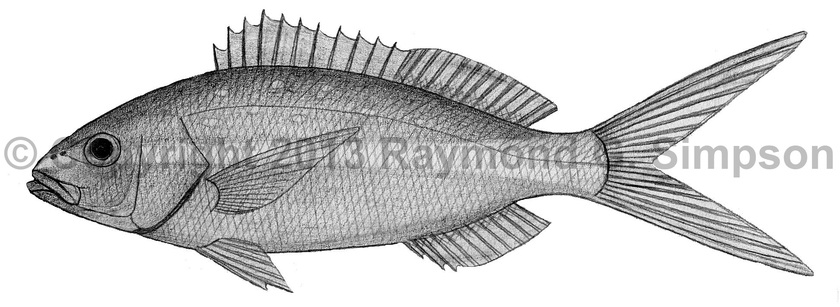
Common Name
Yellowtail Snapper
Year Described
Bloch, 1791
Identification
Dorsal Fin: IX-XI (usually X), 12-14 (usually 12-13)
Anal Fin: III, 8-9 (usually 9)
Pectoral Fin: 15-17
Gill Rakers: 9-11 upper, 21-23 lower; 30-34 total
Lateral Line Scales: 46-49
Body moderately elongate and compressed. Upper and lower jaws with a row of conical teeth. Anterior teeth enlarged. Vomerine teeth in a anchor-shaped patch with a narrow median extension. Palatine teeth an elongate band. Ectopterygoid teeth present. Soft dorsal and anal fins with scales on membranes. Maxilla scaleless. No distinct notch between spiny and soft dorsal fins. Last dorsal ray not elongated. Caudal fin deeply forked, with elongate tips in some specimens.
Color
Body olive, bluish, to reddish above grading to almost white on the belly (some uniformly pale all over). A bright yellow stripe runs from the snout to the caudal peduncle (widening posteriorly). Bright yellow tail is continuous with lateral stripe. Dorsum often with bright yellow spots. Eye white to reddish. Dorsal and anal fins pale yellow.
Size
Maximum size to 81cm TL. Commonly to 40cm TL.
Habitat
Continental waters from 1-165m (usually <70m). Common near coral reefs. Swims in large schools well off the bottom.
Range
Massachusetts to SE Brazil, including the Gulf of Mexico and the Caribbean Sea. Also Bermuda.
References
Anderson, W.D. 2002. Lutjanidae (pp. 1479-1504). In: Carpenter. 2002. The living marine resources of the Western Central Atlantic. Vol. 3: Bony fishes part 2 (Opistognathidae to Molidae). FAO Species Identification Guides for Fisheries Purposes. American Society of Ichthyologists and Herpetologists Special Publication No. 5. FAO of the U.N., Rome.
Loftus, W. F. 1992. Lutjanus ambiguus (Poey), a natural intergeneric hybrid of Ocyurus chrysurus (Bloch) and Lutjanus synagris (Linnaeus). Bulletin of Marine Science v. 50 (no. 3): 489-500.
Other Notes
Lutjanus ambiguus (Poey, 1860) is a natural hybrid between this species and Ocyurus chrysurus (Loftus, 1992). It is likely that Ocyurus is a synonym of Lutjanus and will be moved to that genus. It appears to be a open water eco-phenotype with a more slender body and forked tail as seen in other clades (i.e. Paranthias vs. Cephalopholis).